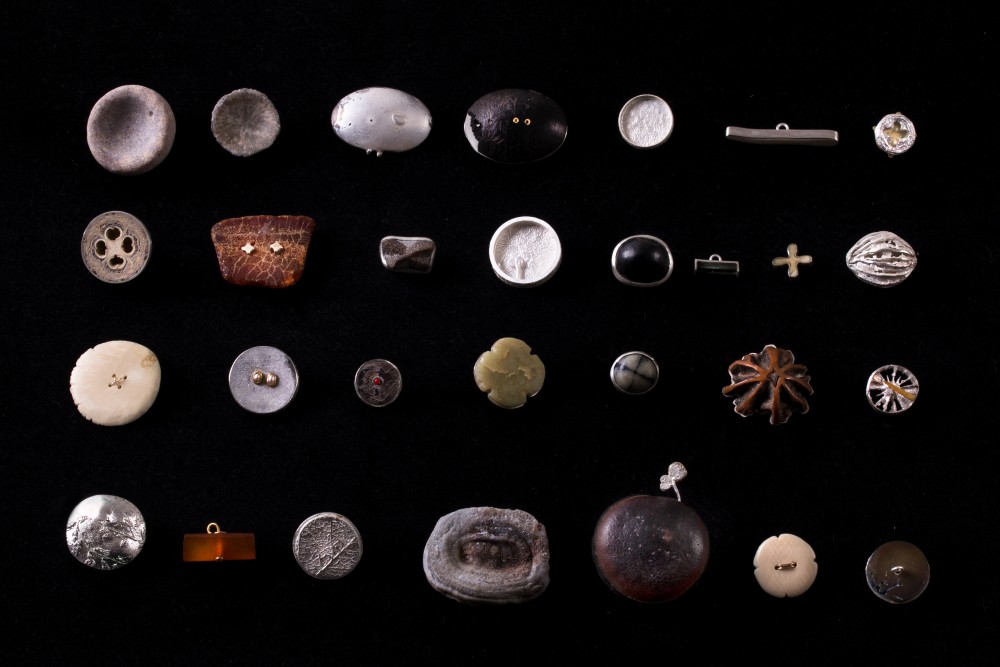Sometimes, trying to express the most important things in life, we run out of words. They get stuck in the throat and refuse to come to the surface right when we need to say something very important or fragile. Or tell the news one would be better off not knowing. Sometimes words abandon and deceive us, they can be misunderstood – and misunderstanding can be responsible for one’s life taking a completely different direction. Although we want to talk about important things more than anything else, we often stay quiet for years, because we simply do not know what those most important things are. However, sometimes it happens that the understanding occurs suddenly – and then all you can do is talk, and listen. Listen to objects and hear yourself through them. Use them as your language.

Eglė Čėjauskaitė-Gintalė, a middle generation Lithuanian metal artist, has long formed a unique and recognizable style. She has had a well-deserved place on the Lithuanian metal art map for quite a while. For more than ten years, Eglė has worked with silver and mammoth bone, crocheting lacework from silver and molding poppy heads. After finding her own technique, the author created jewelry and objects based on the combination of silver lace and precious and semi-precious stones for a long time. Silver lace became the trademark of the artist – flexible, adapting to the shape of the body, elegant and ephemeral; one of her first personal exhibitions was not called Hovering Structures for nothing. However, one technique cannot represent the total potential of the artist forever. One’s field of interest changes, as well as the circumstances and thoughts, so one needs to find new means of expression. Eglė has approached her Baltic roots, managing to yield a modern form to our cultural heritage while maintaining its archaic spirit. The result was the collection called Apparels, in which archaism was expressed through silver textures, Baltic ornaments, and plant symbols. The artist very organically integrated Baltic art into her creative work, which resulted in silver poppy heads that turned into earrings or part of a necklace, the deer with nine antlers from traditional songs, as well as ornamental textures on silver. To some extent, Eglė has always been close to the source that is deep and hard to express in words. Close to the past and history, no matter the modern form of her artworks. The past is impossible without time. Time, its flow and meaning in our life, personal time, disappearing in a watch without hands – a motif loved by the artist.
In her eighth personal exhibition, Eglė Čėjauskaitė-Gintalė develops the theme of personal history in full swing. She has understood the power of personal experience, which gives voice to objects that go before words as opposed to an abstract collective past. Being primary, those “objects-voices,” use things as their language. Therefore, things gain a voice and begin to speak. And Eglė speaks through them. She speaks so openly and intimately and at the same time so tangibly and firmly as never before. It takes courage to speak like that. This manner of speaking is painful and naked. It tells a lot more about us than we would like to hear. Things, mute witnesses of our daily life, aren’t voiceless at all – they just watch and wait for the opportunity to be heard. And they are patient.
Those who have buried someone they loved know that things live much longer than humans. The person is gone for a long time, but their handbag or headscarf is still in a closet, the eye catches Grandma’s spectacles, you still keep an old button that no longer tells you anything. Then you realize that this is precisely what it says – much more than you could have expected – that things that once were an important part of another person’s everyday life in some strange way retain their importance and, what’s more – not only do they keep their own presence, but also to some extent that of their former owner. Things are much more than just objects. A thing acquires a voice, rather, it always speaks, but one needs to find a part within oneself that is able to hear it. Eglė Čėjauskaitė-Gintalė listens to things, restoring and recreating them, turning them into jewelry, giving them new forms and old voices.
Umberto Eco spoke through the lips of Father William of Baskerville: “Signs and signs of signs occur when there is a lack of after objects” Eglė does not lack objects. On the contrary. The exhibition features objects that have transcended matter and acquired spirit. Daily things turned into signs. Household items, found and bought, used by those who are no longer with us. Things made of wood or turning into silver, keeping their form, but acquiring spirit and with it – another purpose. The artist transforms things through the methods of the jeweler, turning them into artistic objects. Creating a very specific and at the same time very generalized image of each object, she retains their authenticity and personality. These items can be recognized by each viewer; we still see them in our daily lives, although we used to see them more often in the past. These items were once used by the author’s Nana, but didn’t we all have Nanas, Nannies or Grannies who embroidered tablecloths and darned our socks. So this is about us, too. Personal memories become collective, they speak about the past, about quiet, yet proud existence. Buttons kept in a tin candy box in every home, in the artist’s interpretation acquire greatness and become some kind of amulets. Scissors with a notched piece of a metal headscarf – an object of jewelry hides a threat that the Samogitian Moira may at any given moment cut the thread of your life. Colorful flowers, a picture of beauty from the tablecloth embroidered by Nana, in the exhibition, bloom like a monument to patience, silence, and inner peace – everything that we often so hopelessly long for. A kerchief, an inseparable attribute of older women, shines its silver, reminiscent of chainmail. After all, they had to defend themselves numerous times in their life – from glances, from words, from poverty. Their weapons: a glance, a word, endless work. Indeed, the flexible and glossy pieces of silver fabric Eglė laced with her own hands are among the most memorable objects. They are decorative and glowing, and are the proof of how the author manages to beautify, ennoble, and sublimate components of everyday clothing as well as all of the former modest, hard, often silent, but always authentically proud daily life of the people of the past. Those fragments of former existence speak up and they speak the Samogitian dialect. This language is unsuitable for lofty matters, but it may help you prudently and cautiously to talk about the “higher moments” that our famed poet Vytautas Mačernis talked about. Now, when things acquire voices and words, they sometimes speak the words of a Samogitian poet Viktorija Daujotytė, who expresses what Eglė hears and feels more accurately than she herself is able to. The poetry is also quite modest, it’s slow and full of pauses, mostly sad and always filled with a sense of value. Authentic value, when there’s no need to prove anything to anyone or argue with anyone because this would not change anything. Things always remain as they are. Those words give things a sound – a Samogitian sound, which is rather stern. But it’s all right because the objects are from Samogitia and so are Eglė Čėjauskaitė-Gintalė and her family. This is a unique return, through things and words, to a place, it turns out they never left. Sometimes words are parallel to things, sometimes what remains of them is only a few letters from a Samogitian dialogue caught in a sieve. According to Viktorija Daujotytė, things “gained body from matter”, gained a name from a look.
This exhibition is like a restored fragment of the Samogitian universe. A place of the former (perhaps) harmonious existence, nature and holiness of everyday routines. It is no coincidence that the objects are exhibited in chapels, thereby emphasizing their sacredness. The emphasis is neither pompous nor reproaching. They are as sacred as is the timeworn handle of a baker’s peel polished by the hands of a few generations of bakers. They are sacred by their very existence, by their transformation into jewelry, not decorative, but one that speaks about memories and the return to a place that is important and true. Where time is slow, the language – Samogitian, the words – down to earth, moderate and unhurried, where one is surrounded by unrecognized and unrecited poetry, hard, sometimes stern, which would perhaps not like to be called poetry. But what if this place never existed, and all those things were made out of longing and fictional memory? In any case, everything is very raw and true – to oneself, the people, and the objects. There is no distance, no retreat, no introspection or self-irony. All things speak in their own true voice.
